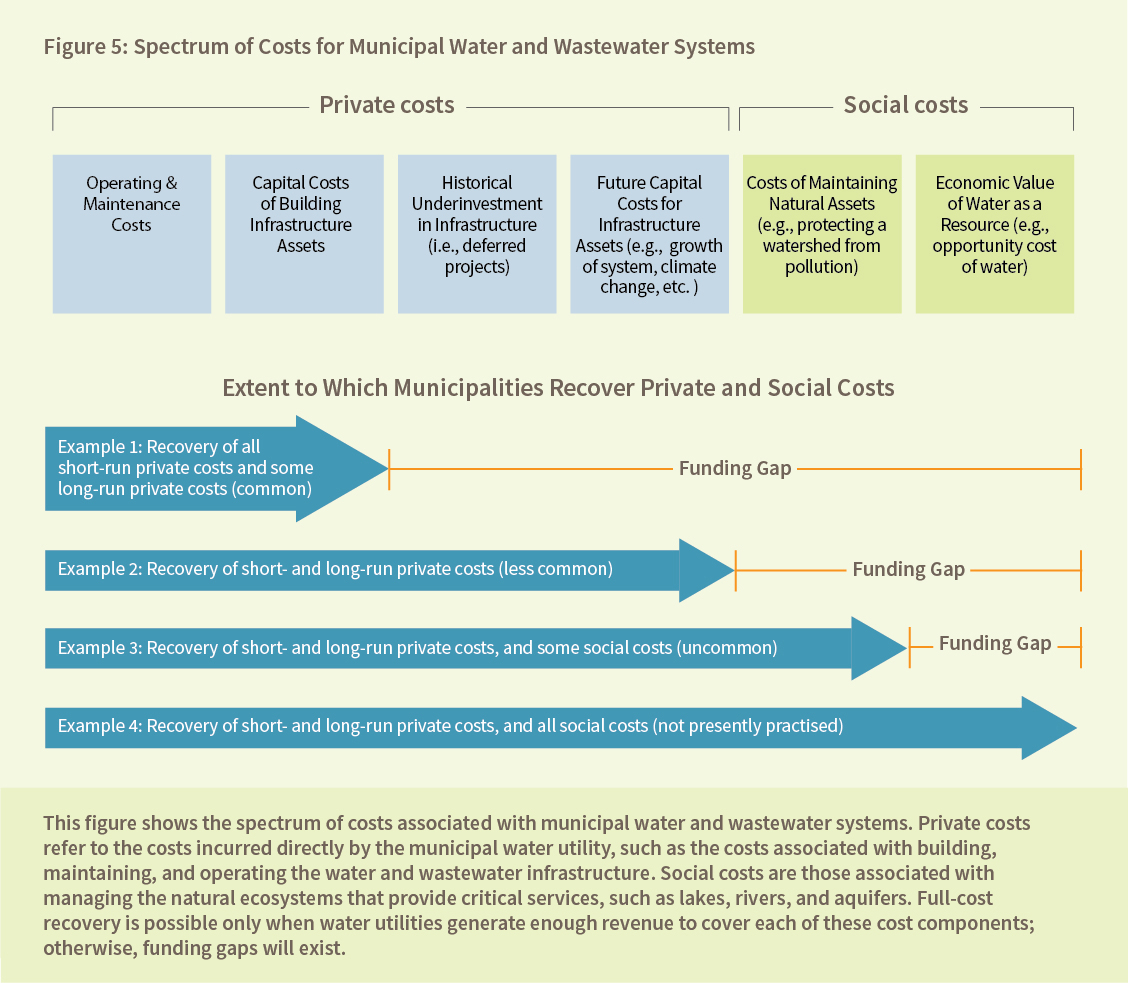
TLDR: How user fees can improve the environmental and financial sustainability of municipal water and wastewater services
It’s easy to forget how important municipal water and wastewater services are in our daily lives. These complex systems treat and deliver water for millions of Canadian households and businesses—vital to our health, the economy, and the environment. Yet municipal water systems across Canada face significant challenges. The Ecofiscal Commission’s latest report, Only the Pipes Should be Hidden: Best practices for pricing and improving municipal water and wastewater services, assesses how well-designed user fees can help address these challenges by encouraging conservation, funding infrastructure, and protecting our water quality.
Why water, why now?
When it comes to the economics of municipal water and wastewater—and how we pay for the infrastructure that provides these services—Canadian municipalities have made considerable progress. Increasingly, Canadian municipalities are relying on user fees to finance their systems. User fees (i.e., paid water rates through monthly or quarterly bills) creates a price signal that helps drive conservation and provides revenue to ensure that water and wastewater systems are kept in good shape.
Despite this steady progress, however, Canadian municipal water systems face significant challenges. The prices Canadians pay for water and wastewater services are some of the lowest in the world and don’t reflect the full costs of providing and maintaining these services. And these costs are increasing. Many municipalities have aging infrastructure that requires significant investments in the coming decades.
At the same time, some of the natural ecosystems on which municipal water systems depend are stressed. Canadians are heavy water users by international standards. Population growth, urbanization, and low water levels during summer months pose risks to the sustainability of water supplies, intensified by the impacts from climate change. Moreover, the waste and chemicals that go down our drains can degrade natural ecosystems, despite best efforts by municipalities to use more sophisticated treatment technologies. When undertreated, this wastewater affects the quality of our lakes, rivers, and oceans.
Well-designed user fees can help
Well-designed user fees sit at the nexus of resolving these complex and interconnected challenges. They can both generate revenue and act as an important price signal. While user fees alone are not a silver bullet for all water-related problems, they play a key role.
Unlike other financial or environmental policies, user fees establish a direct link between the costs of the service and the price paid by households and businesses using the water. Those who use less water, pay less; those who use more, pay more. This sends a clear pricing signal to conserve and helps reduce the long-term costs of building and maintaining the system.
User fees are also more flexible than other financial instruments. They can be designed in different ways, allowing municipalities to tailor rates according to their local context. The revenues from user fees must also—by law—go back into paying for the service. This ring-fences revenues for water utilities, which provides stable funding and helps with long-term planning.
Paying the full cost
Well-designed user fees are fundamentally about changing how we pay for water and wastewater services. But they’re also about how much we pay. Indeed, environmental and financial sustainability is only possible when water utilities recover the full cost of providing the service.
The notion of setting prices to recover the full costs of a service is intuitive; however, the prices of water and wastewater services in Canada have been set at below-cost prices for decades. As a result, water utilities have not generated enough money to make required upgrades and repairs on their systems (see figure). Although municipalities are chipping away at this gap with increased investments, many still struggle with how to foot the bill.

User fees can help municipalities reach full-cost recovery and reverse the effects of decades of underinvestment in infrastructure. User fees can also make water utilities more financially independent, less reliant on funding sources from outside the local government.
Best practices from coast to coast
Municipalities across Canada are already leading the way forward. Our report includes five case studies, highlighting both the challenges and opportunities with implementing user fees. Each municipality has its own priorities—and face their own unique context—but in all cases, user fees can generate economic and environmental benefits.
Based on this progress, our report provides a set of 10 best practices.
We start with the fundamentals of well-designed user fees, such as installing water meters and developing strategies that define and recover the costs of service. The City of Ottawa, for example, requires all units—new and old—to have water meters. The city has also recently upgraded its analog meters to smart meters, which enables the city to more closely track water consumption and detect leaks. These changes lead to a more efficient system.
From there, we cover the principles of well-designed user fees. Adopting multi-rate user fees, for examples, mean that municipalities charge a basic fixed amount to households and businesses (either monthly or quarterly), in addition to a volume-based rate that varies with the level of water consumed. On one hand, the fixed amount provides revenue stability for water utilities, and helps pay for the utility’s large fixed costs (e.g., vast infrastructure networks). On the other, the volume-based component maintains a price signal to create incentives for conservation. In Gibsons, B.C., multi-rate user fees are at the core of its strategy to drive conservation and fully recover its costs, which includes the costs associated with protecting its pristine, underlying aquifer.
Many municipalities across Canada are implementing some of these best practices, but few are doing all of them. That means there’s an opportunity for changing the way we pay for water and wastewater services to make sure our water systems are both environmentally and fiscally sustainable.
The infrastructure that treats and delivers our water and wastewater might be hidden. But the price we pay for these services should be in plain sight.
Read the Report Check out our Events



Comments are closed.